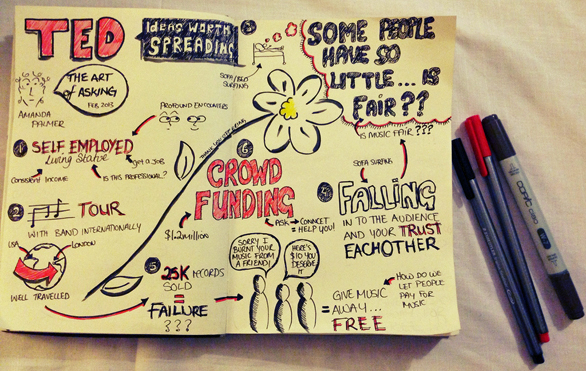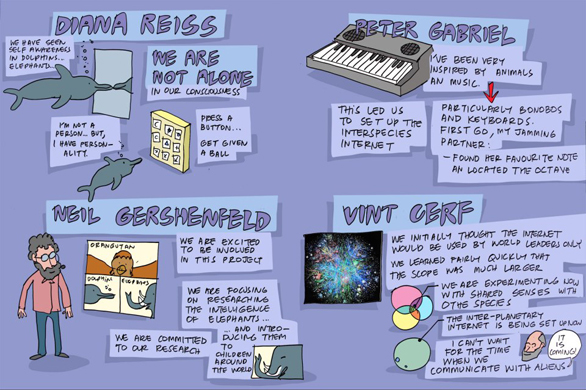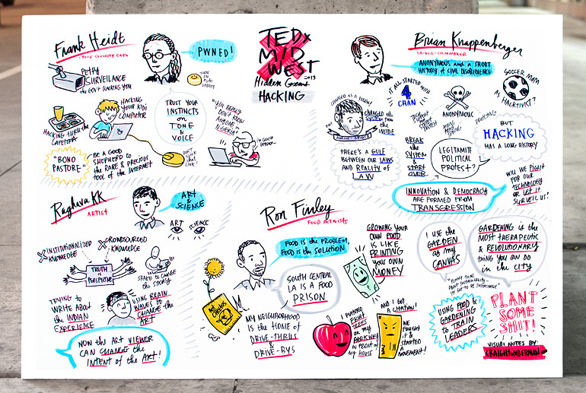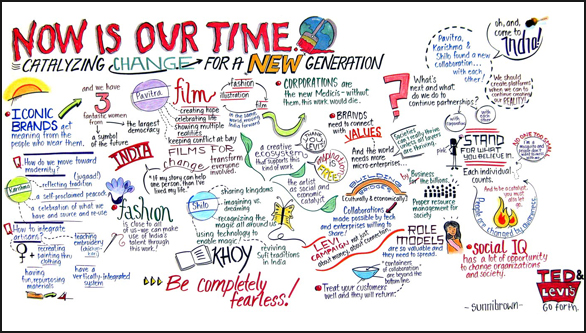
Makayla Lewis sketched these notes while watching Amanda Palmer’s TED Talk online.
At TED 2011, Sunni Brown encouraged doodling everywhere – classrooms and meeting rooms included. “The doodle … engages all four learning modalities simultaneously, with the possibility of an emotional experience,” she says in her classic talk. [ted_talkteaser id =1230]Yes, it’s proven that doodling helps you remember things more efficiently.
Graphic notetaking is the doodle, evolved and tamed. So it is no surprise that the many creative people and visual learners who attend TED conferences and locally organized TEDx events choose this method for capturing information.
What does a graphic notetaker do? They must majorly multitask: they listen to a talk, synthesizing everything a speaker is saying, breaking down everything into phrases and drawings, linking ideas and statements, and adding aesthetic details and colors. All of this is done in real time, with little to no briefing beforehand. It requires more than a good eye or artistic talent; you need an excellent ear practiced in active listening. An arsenal of visual vocabulary doesn’t hurt, either.
We’ve scoped out the wildest graphic notes floating around the TED ecosystem and culled great tips for graphic notetaking, from the masters themselves:
- Gavin Blake of Australian graphic facilitation agency Fever Picture set up a huge whiteboards at TEDActive 2013, where he drew notes depicting the essence of each talk at the conference. His key pieces of advice: Be as present as possible, keep the current of visualizing and iterating going, and don’t worry about things falling through the cracks. Read more »

- Craighton Berman, the artist who created graphic notes for TEDxMidwest in his Sketchnotes 101, has advice too. “Instead of recording what’s being said verbatim, good sketchnotes capture the meaningful bits as text and drawings. Better sketchnotes use composition and hierarchy to give structure the content and bring clarity to the overall narrative of the lecture. The best sketchnotes express a unique personal style and add editorial comments on the content entertaining and informing all at once,” he says. He recommends every graphic notetaker have a toolbox of typography, text spacing, containers, connectors, frameworks, icons, shading and color.

- Sunni Brown, in her master list of visual notetaking tips and truisms, focuses on the very foundation of the art: listening. She writes about the importance of picking out metaphors and similes, descriptor cues and paying attention to the narrative build. But most importantly, she says, you need to turn all other voices off: “Suspend your own frame of reference. Focus externally. Turn off your ego. Quit thinking everything revolves around your opinion. Give the stage in your head to someone else!”

- The artistic trio of Fernanda Deuriarte, David Christie and Tom Oswald from Innovation Arts will be the graphically scribing TEDGlobal 2013, “Think Again,” which kicks off today in Edinburgh, Scotland. (Watch their progress June 10 to 14 on our Flickr page, as you follow the conference beat-by-beat here on the TED Blog.) They offer three tips:
- The less you think about it, the better the result. If you concentrate too much on each task it becomes almost impossible. It’s like being in a state of flow.
- Illustrations are great to make your sketchnote engaging, but it’s more important to get the essence of the conversation, to get your structure right. Map out a start, middle and end and let your audience read the story you’re trying to tell.
- Don’t be afraid to stop and listen. You’ll usually be able to summarize two or three paragraphs into a few words and a nice illustration.
.
Comments (20)
Pingback: ImageThink Sketchnotes at TED's 2013 99U Conference
Pingback: Doodle Power | FromTheCore
Pingback: Doodle Power | From the Core
Pingback: Links for a Monday | PKG
Pingback: A field guide to TED graphic notes | TED Blog | Nanaimo Artist Way
Pingback: Sketchnotes & TED | ImageThink
Pingback: Weekly Diigo Posts (weekly) | The Reading Zone
Pingback: Gallery: Behind-the-scenes at Tuesday and Wednesday of TEDGlobal | H Tanalepy
Pingback: A field guide to TED graphic notes | TED Blog | dawescoa
Pingback: Why Visual Note-Taking Works for Some Students | iAMSTEM HUB . UC DAVIS
Pingback: How to sketch valuable notes
Pingback: How to sketch valuable notes - The Visual Marketing Revolution